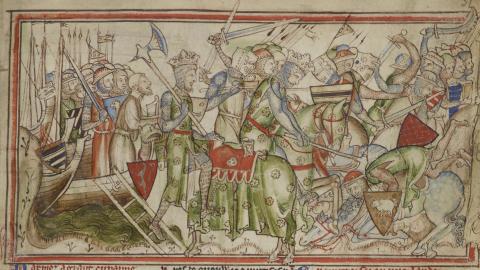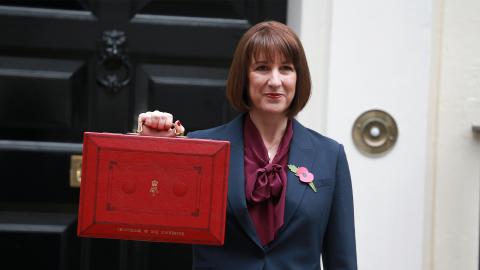11 unusual nicknames for British kings and queens
From affectionate nicknames such as ‘Farmer George’ and ‘Silly Billy’, to downright derogatory ones such as ‘Lackland’, ‘The Prince of Whales’ and ‘Crouchback’, we take a look at some of the more unusual royal nicknames.
1. Crouchback / Crookback - Richard III

It wasn’t known for certain for centuries if Richard III’s nicknames were dreamed up by his enemies, or if he actually did suffer from a physical deformity. Most famously portrayed as a hunchback in William Shakespeare’s play that bears his name, it wasn’t until Richard’s bones were discovered under a car park in Leicester in 2012 that the mystery was finally solved. The king’s skeleton revealed he had scoliosis - a distinct curvature of the spine.
2. Farmer George - George III
George III was King of Great Britain and Ireland for 60 years, and while he is best remembered for being on the throne when Britain lost the American War of Independence, as well as for going mad in his later years, he earned the nickname ‘Farmer George’ because of his keen interest in agricultural matters. George was fascinated by farming and would often scribble notes in the margins of agricultural books and pamphlets.
3. Ironside - Edmund II
Succeeding the throne from his father Ethelred the Unready in April 1016, Edmund was immediately embroiled in his father's war with the Danes. Over the course of the next six months, Edmund fought five battles, eventually losing to his rival Cnut in October. In recognition of his exceptional bravery, he was nicknamed ‘Ironside’ for his strength and courage. He wasn’t around to enjoy his nickname for long. Edmund died in November at the age of 25 having ruled England for just seven months.
4. Lackland / Soft-Sword - John
John was called ‘Lackland’ because he literally lacked land. The younger brother of Richard the Lionheart, John was not expected to inherit lands of any consequence, hence the nickname. However, when his brother died in 1199, the nickname no longer applied. John was quickly renamed ‘Softsword’ after he agreed to let Philip II become the feudal overlord of his lands in France without putting up a fight.
5. The Prince of Whales - George IV
George IV consumed enormous quantities of food and wine, so much so that he grew to a quite gargantuan size during his time as both Prince Regent and King. Unfortunately, he did so at a time when a new form of humour called ‘satire’ was booming in England, and the prince’s gluttonous habits were ripe for ridicule. Cartoons of the corpulent prince gorging himself appeared regularly in pamphlets circulated at the time, some of which depicted George as a whale, hence the nickname ‘The Prince of Whales’.
6. Sailor King / Silly Billy - William IV

As a young man, William IV was a rather giddy and excitable character, earning him the nickname ‘Silly Billy’. After ascending the throne in 1830, he is supposed to have proclaimed, ‘Who’s the Silly Billy now?’ William quickly became known as the ‘Sailor King’ due to the fact he had joined the Royal Navy at the age of 13, seeing action during the American War of Independence. William later became good friends with Lord Nelson, who described him as superior to two-thirds of the officers serving at that time. So, perhaps not such a ‘Silly Billy’ after all.
7. The Be-Sh*tten - James II
Ascending the throne in 1685 after the death of his brother Charles II, James II proved to be one of the most unpopular kings in British history. James outraged his nobles when he kicked them out of office and replaced them with Catholic loyalists. His daughter, Mary, and her powerful husband, William of Orange, were invited to take over, leading to James fleeing to France when William arrived at the head of a Dutch army. James then went to Ireland, which remained loyal to him. He raised an army but lost the Battle of the Boyne against William’s forces in 1688. In response, James ran away to France again, earning him the nickname ‘the Be-Sh*tten’ by his Irish subjects, or alternatively ‘James the Sh*t’.
8. The Unready - Ethelred
Ethelred’s reign is chiefly remembered for ordering the massacre of Danish settlers in England in 1002, and for having a nickname that sticks in the head of every primary school child. It actually wasn’t until 150 years after his death that Etherlred became known as ‘the Unready’. After the hash he made of ruling the country and the poor advice he received, he was given the epithet ‘the Unready’, which means ‘the poorly advised’ - a play on Ethelred’s name, which means ‘the well advised’.
9. Mrs. Brown - Victoria

Following the death of her beloved husband Albert in 1861, Queen Victoria went into an extended period of mourning, withdrawing from public life to Osborne House on the Isle of Wight. To cheer the queen up, her secretary summoned ghillie (outdoor servant) John Brown from her Balmoral estate to keep her company. The two struck up a close friendship, which led to rumours that Brown and the queen were more than just friends. This earned Victoria the nickname ‘Mrs. Brown’. Victoria resisted attempts to dismiss her beloved ghillie, and Brown remained her devoted servant until his death in 1883.
10. Old Coppernose - Henry VIII
Thanks to Henry VIII’s lavish spending habits and ruinous foreign wars, England’s finances were in a pretty poor state in the 1540s despite the king dissolving the monasteries and stripping them of their treasures. To save money, the king ordered coins to be made from cheaper metals. The penny was one such coin, which was changed from pure silver to copper with a thin silver veneer. This was so thin, that it quickly began to rub off, often from the nose of the portrait of the king first. This resulted in the king having a copper nose, earning him the nickname ‘Old Coppernose’.
11. Dirty Bertie - Edward VII
Edward VII had a voracious sexual appetite. Prince of Wales for decades - and deliberately kept away from state affairs by his mother, Victoria - Edward had plenty of time to indulge his favourite hobbies of eating, drinking, smoking enormous cigars and having sex as much as possible. He had a string of affairs and was a frequent visitor to the high-end brothels of Paris. As well as being nicknamed ‘Dirty Bertie’, the randy prince was also known as ‘Edward the Caresser’.















